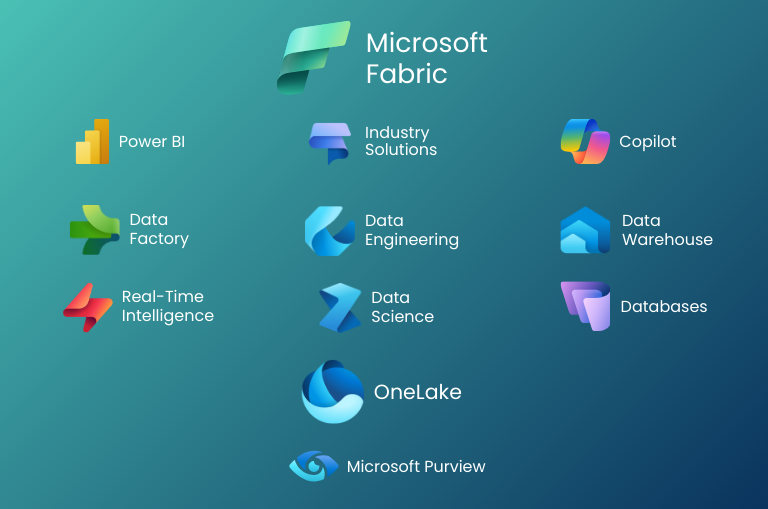Oracle Autonomous Data Warehouse vs Microsoft Fabric: Data Platform Comparison
Effective digital transformation is inseparably linked to the implementation of highly efficient data platforms that can handle complex tasks of collecting, advanced processing, and in-depth analysis of ever-growing and increasingly complex sets of information.
In this dynamic technological landscape, Oracle Autonomous Data Warehouse and Microsoft Fabric emerge as some of the most innovative solutions currently available on the market. These advanced platforms offer enterprises a unique opportunity to harness the hidden potential of their data fully and to transition toward intelligent, AI-driven solutions effectively.
What are modern data platforms?
A modern data platform is a comprehensive solution that enables management of the entire data lifecycle – from acquisition through storage and processing to analysis and visualisation.
Unlike traditional systems, modern platforms offer scalability, flexibility, and advanced analytical capabilities, often utilising the cloud as an operational environment, eliminating the need to manage physical infrastructure.
What is Oracle Autonomous Data Warehouse
Oracle Autonomous Data Warehouse (ADW) is the world’s first autonomous database optimised for analytical workloads, including data marts, data warehouses, data lakes, and lakehouses. It uses artificial intelligence and machine learning to automate administrative tasks, eliminating the need for manual management. It is self-managing, self-securing, and self-repairing, allowing analysts and data scientists to focus on discovering valuable insights.
Oracle ADW is based on Exadata infrastructure, which delivers exceptional performance for analytical workloads. The autonomous architecture uses advanced machine learning algorithms for self-optimisation, eliminating the need for manual tuning. The system automatically manages indexing, tuning, and scaling, monitoring all aspects of operation and making autonomous adjustments. This ensures consistently high performance while reducing administrative costs.
Strengths
The greatest strength of Oracle Autonomous Data Warehouse is its autonomy – the system manages, secures, and repairs itself, eliminating the need for manual administration and reducing operational costs by an average of 63%. The platform offers exceptional performance thanks to Exadata technology and advanced query optimisation. It allows independent scaling of compute and storage resources, providing better cost control. ADW ensures advanced security with automatic encryption and protection of sensitive data.
Weaknesses
Despite its advantages, Oracle Autonomous Data Warehouse can generate higher costs compared to some competing solutions, especially for smaller organisations. The platform is closely tied to the Oracle ecosystem, which may pose challenges when integrating with tools from other vendors. Full utilisation of ADW's capabilities may require knowledge of Oracle technology and SQL. Although it offers multi-cloud support, it performs best on Oracle Cloud Infrastructure, which can limit flexibility in choosing a cloud provider.
Integrations
Oracle ADW offers advanced integration with a variety of systems and platforms. It enables data analysis from various cloud sources, including AWS, Azure, and Google Cloud. It supports different data formats such as Apache Parquet, JSON, Apache ORC, Apache Avro, CSV, and XML. It integrates with Oracle Analytics Cloud, Tableau, and other Business Intelligence tools. ADW ensures compatibility with existing Oracle applications, allowing smooth migration of workloads from on-premises to the cloud.
AI and Machine Learning
Oracle ADW provides built-in machine learning features that eliminate the need to move data to separate ML systems. The platform offers ML-based automatic database tuning, intelligent indexing, and adaptive caching. It allows building, training, and deploying predictive models directly within the database. Oracle AutoML automates many tasks related to model creation, making it easier for business analysts to use advanced forecasting capabilities without deep technical knowledge.
Pricing Model
Oracle ADW offers a flexible pricing model based on ECPU units (formerly OCPU). It can be deployed on one of three infrastructure types: Serverless, Dedicated Exadata Infrastructure, or Exadata Cloud@Customer. Prices vary depending on the deployment model, but compute is billed in the same way. A fixed-shape instance (4 ECPU with 20 GB) is available for developers at an hourly rate. Elastic Pools allow for the consolidation of databases into a single pool, providing up to 87% savings.
When to choose Oracle Autonomous Data Warehouse
Oracle Autonomous Data Warehouse is the best choice if your organisation needs maximum performance and scalability for complex analytical workloads. Choose ADW when the priority is minimising administrative work through autonomous database management features. It is also an ideal solution if you already use Oracle technologies and are looking for smooth integration. ADW is also suitable in regulated industries where advanced security features and compliance are critical.
What is Microsoft Fabric
Microsoft Fabric is a comprehensive analytics and data platform that combines various tools in one environment. Based on a SaaS architecture, it integrates components such as Data Factory, Data Engineering, Data Warehouse, and Power BI.
Its central element is OneLake – a unified data repository. Fabric offers built-in AI features, including Microsoft Copilot, enabling task automation and intelligent analysis generation.
Microsoft Fabric is based on a SaaS architecture with OneLake as the central component, eliminating data silos. The platform connects all data workloads from data engineering through warehousing to real-time analytics.
Benefits include centralised data management, seamless integration with the Microsoft ecosystem, built-in AI features, and a medallion architecture (bronze-silver-gold) supporting data processing from raw to advanced analysis.
What is Microsoft Fabric? A guide for companies
Strengths
Microsoft Fabric stands out with the comprehensive integration of all aspects of data analytics in a single platform. A key advantage is OneLake – a unified repository eliminating data silos. Fabric offers a wide range of analytical tools tailored to various organisational roles. Native integration with the Microsoft ecosystem (Power BI, Azure, Microsoft 365) ensures seamless workflows. Built-in AI features, including Microsoft Copilot, automate tasks and provide intelligent insights. Fabric also enables comprehensive data management with access control and regulatory compliance.
Weaknesses and Limitations
Despite its comprehensiveness, Microsoft Fabric has limitations. The platform is strongly tied to the Microsoft ecosystem, which can hinder integration with solutions from other providers. Fabric is a relatively new product and has less mature features compared to specialised tools. Multi-cloud flexibility is limited mainly to Azure. The capacity model may be less flexible for organisations with variable computing needs. Additionally, the platform’s complexity can lengthen the learning curve for new users.
Integrations
Microsoft Fabric offers native integration with the entire Microsoft ecosystem, including Microsoft 365, Microsoft Azure, Microsoft Copilot Studio, and Microsoft Power Platform. It also has numerous connectors to external systems, including Snowflake, Google BigQuery, MongoDB, and AWS S3. Thanks to Data Factory, Fabric can retrieve data from various structured and unstructured sources. Integration with Power BI provides advanced visualisation capabilities, and connection with Microsoft Azure AI Foundry enables the use of advanced artificial intelligence features.
AI and Machine Learning
Microsoft Fabric offers advanced AI capabilities through integration with Azure Machine Learning in Microsoft Azure AI Foundry and Microsoft 365 Copilot. The platform enables the creation, deployment, and management of ML models within a unified environment without the need to switch between tools. AI features are built into the entire data lifecycle from engineering to business analysis. Fabric automates routine tasks, creates quick reports, and builds auto-models, making it a good choice for companies seeking integrated AI experiences.
Pricing Model
Microsoft Fabric offers two main pricing models: Pay-as-you-go (flexible with no commitments) and Reserved (with savings up to 40% for yearly reservations). Costs depend on two main factors: compute and storage. A single compute capacity can support all functions simultaneously and be shared across multiple projects. Fabric also offers three license types for users: Free, Pro, and Premium per-user.
When to choose Microsoft Fabric data platform
Microsoft Fabric is an optimal choice for organisations already using the Microsoft ecosystem. It is suitable for companies looking for a comprehensive solution covering the entire data lifecycle – from acquisition to visualisation. It is ideal for enterprises needing to integrate various teams (data engineers, analysts, data scientists) on a single platform.
Fabric is also a good fit for organisations wanting to leverage advanced AI features without building complex infrastructure by using built-in tools supported by Microsoft Copilot.
What is the difference between Oracle Autonomous Data Warehouse and Microsoft Fabric?
Oracle ADW and Microsoft Fabric represent different approaches to data analytics. ADW is primarily an autonomous database optimised for analytics where the key value lies in administrative task automation, self-optimisation, and minimal human intervention. In contrast, Fabric is a comprehensive platform integrating various analytics services in one environment.
ADW focuses on delivering top performance for data warehouses using Exadata technology and advanced automation. Microsoft Fabric takes a broader approach, offering a unified platform for different roles within the organisation with integration into the Microsoft ecosystem (365, Power BI). The key difference is that Oracle ADW provides a self-operating autonomous database while Microsoft Fabric offers a collaborative environment that unifies various analytics tools into a consistent user experience.
The choice between them depends on existing infrastructure, specific analytical needs, and organisational integration preferences.
Which system to choose for a company
Small company
For a small company, the key selection factor is ease of implementation and minimisation of administrative costs.
For small companies, Microsoft Fabric is often a more accessible choice due to its easy integration with commonly used Microsoft 365 and Power BI tools. The lower entry barrier and user-friendly interface allow quick deployment without specialised technical knowledge. The Pay-as-you-go pricing model enables flexible scaling as the company grows. For small teams, the unified analytics environment is valuable as it eliminates the need to manage multiple tools. If you already use the Microsoft suite, Fabric will be a natural extension.
Medium-sized company
A medium-sized company should base the decision on existing IT infrastructure and specific analytical needs.
Medium-sized companies should base their decision on existing IT infrastructure and strategic goals. If they already have investments in Oracle technologies, ADW may offer better integration and performance. For organisations using the Microsoft ecosystem, Fabric will be the more natural choice. It is also important to consider available competencies – Oracle ADW requires knowledge of SQL and Oracle technologies, while Fabric offers a more user-friendly environment for less technical users. Specific analytical requirements and long-term costs should also be analysed.
Large company
Large enterprises should make the decision based on IT strategy, existing investments, and long-term data management vision.
Large companies should conduct a thorough analysis of their data processing needs. Oracle ADW provides exceptional performance for complex analytical workloads and the established security required in regulated industries. Microsoft Fabric offers better integration in Microsoft-based organisations and a unified environment for various teams. Large companies often choose a hybrid approach, using both solutions for different purposes. It is also crucial to consider a multi-cloud strategy and industry compliance requirements.
Summary
Oracle ADW is characterised by advanced autonomous management features and highly optimised performance for handling complex and demanding analytical workloads, making it ideal for enterprises seeking maximum computing power and minimal ongoing system administration involvement.
For companies already heavily using Oracle technologies and with infrastructure built on these solutions, Oracle ADW will be a natural and logical choice, providing synergy and optimisation of existing investments.
Implementing Microsoft Fabric will be a better choice for organisations integrated with the Microsoft ecosystem, valuing ease of deployment, a unified environment, and ease of use without the need to manage infrastructure.
The decision between Oracle Autonomous Data Warehouse and Microsoft Fabric should be carefully considered and directly result from specific business needs, existing IT infrastructure, and the organisation's long-term strategic goals.


